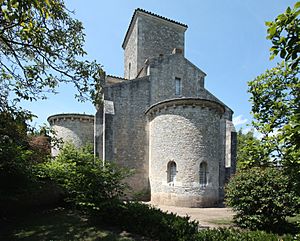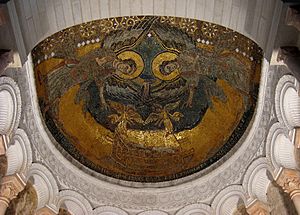Theodulf of Orléans facts for kids
Theodulf of Orléans was an important writer, poet, and Bishop of Orléans. He lived from about 750 or 760 until December 18, 821. Theodulf served during the time of powerful kings like Charlemagne and Louis the Pious. He was a key person in the Carolingian Renaissance, a period when learning and culture grew a lot. He also helped Charlemagne make many changes to the church.
Theodulf is best known for likely writing the Libri Carolini. This book explained the Western Church's views on religious art. People also remember him for his private chapel at Germigny-des-Prés. This chapel has a beautiful mosaic that is still around today. Thanks to his work, some parts of the Bible, like the Book of Baruch, became part of the Western Bible.
Contents
Theodulf's Life Story
Theodulf was born in Spain, probably in a city called Saragossa, between 750 and 760. His family came from the Visigothic people. He had to leave Spain because the Moors took over the area. He traveled to a region in France called Aquitaine, where he got his education. Later, he joined a monastery near Maguelonne in Southern France.
In 786, Theodulf visited Rome. He was very impressed by the schools and learning centers there. He then sent letters to many church leaders across the Frankish empire. He encouraged them to start public schools for everyone.
Working with Charlemagne
King Charlemagne saw how important Theodulf was. Around 798, Charlemagne made him the Bishop of Orléans. He also put Theodulf in charge of several monasteries, including the famous Benedictine abbey of Fleury-sur-Loire. Theodulf then started public schools outside the monasteries, just as he had planned after his trip to Rome.
Theodulf quickly became one of Charlemagne's favorite thinkers, along with Alcuin of Northumbria. He helped Charlemagne a lot with his plans to improve the church. For example, he checked and corrected many translated texts that Charlemagne thought were wrong. He also translated holy texts directly from Greek and Hebrew. In 811, he was even a witness to Charlemagne's will.
Challenges and Later Years
Charlemagne passed away in 814. His son, Louis the Pious, became the new emperor. Louis's nephew, King Bernard of Italy, wanted to be independent from the Frankish empire. He gathered an army against Louis. Bernard eventually gave up, but Louis punished him severely.
Louis believed that many people in his court were secretly working with Bernard. Theodulf was one of the people accused of treason. In 817, he was forced to leave his job as Bishop of Orléans. He was sent away to a monastery in Angers in 818, where he stayed for two years.
After being released in 820, Theodulf tried to get his bishop job back in Orléans. However, he never made it back to the city. It is thought that he died during his journey or soon after. Theodulf of Orléans died on January 18, 821. His body was brought back to Angers and buried there.
Some old writings suggest that Theodulf might have been married early in his life. They say he had a daughter named Gisla.
Theodulf's Chapel at Germigny-des-Prés
The chapel at Germigny-des-Prés is a great example of Carolingian architecture. Bishop Theodulf built it in 806. It was part of his large country home, or villa, in Germaniacus. Theodulf was also in charge of the nearby monastery of Saint-Benoît-sur-Loire. His home and chapel were somewhat like Charlemagne's Palace of Aachen, which was the main center of the Carolingian Empire at that time.
Most of Theodulf's villa was destroyed by the Normans (who were once Vikings) within 100 years. But the chapel survived! The villa used to have fresco paintings showing the Seven liberal arts, the Four Seasons, and a world map (called a Mappa Mundi).
The mosaic in the chapel is one of the very few Carolingian mosaics that still exist. It was heavily repaired in the 1860s, which many people agree was not done very well. The mosaic shows the Ark of the Covenant with angels. This image is usually only found in early Jewish Bibles. It probably connects to the Libri Carolini, where the Ark is mentioned as proof that God approved of religious images.
Theodulf's Writings
Theodulf wrote many important texts, including church rules and beautiful poems.
Church Rules (Capitularies)
As Bishop of Orléans, Theodulf wrote two important sets of church rules, called capitularies.
- Capitula ad presbyteros parochiae
This first set of rules reminded priests in his area about how important it was to work with their hands, study, pray, and live a pure life.
- Capitula altera Theodulpho episcopo Aurelianensi adscripta
This second set of rules covered many topics for priests and people in the church.
Hymns and Poems
Theodulf also wrote hymns and poems. About 80 of them are still around today. His most famous one is Gloria, laus et honor.
The Libri Carolini
Theodulf was almost certainly the person who wrote the Libri Carolini around 793. This book was a response to a wrong translation of the rules from the Second Council of Nicaea in 787. The translation wrongly suggested that "worshipping" images was okay in the church.
The Council had actually said that the time of Iconoclasm (destroying religious images) should end. This was partly true, but the wrong translation made it seem like images should be worshipped. This incorrect translation reached Charlemagne's court and made him and his loyal thinkers, like Theodulf, very angry. Charlemagne ordered Theodulf to write the Libri Carolini in his name. The book showed Charlemagne as the main leader of the Western world and a protector of the church against what they saw as idolatry (worshipping idols).
The Libri Carolini explained that images could be used as church decorations. They could also help teach people and remember past events. However, it said it would be foolish to burn incense or use lights in front of them. But it also said it was wrong to throw them out of churches or destroy them. The book strongly disagreed with "adoring" images. It believed the Council in Nicaea used this word to mean the absolute worship meant only for God. Instead, it said that saints should be given proper respect, and the Cross of Christ, the Bible, holy items, and relics of saints should be honored. The Greek word the Council actually used, προσκύνησις, simply meant showing respect by bowing down.
Theodulf's Important Beliefs
Theodulf brought new ideas and an open mind to the Carolingian Renaissance.
Being Welcoming (Hospitality)
Theodulf believed in always being welcoming. He thought people should never turn away travelers, pilgrims, or the poor if they needed food or a place to stay. He felt that if you offered a meal to those less fortunate, you would one day be welcomed at God's banquet. These ideas came from his reading of a writer named Augustine. Theodulf often called himself a "poor traveler" or "stranger." This was because he was born in Spain and was of Visigothic descent, but he was welcomed by Charlemagne's royal court.
Love for Books and Learning
Theodulf loved to read Christian books. In one of his letters to Pope Leo III, he listed some of his favorite writers. These included Gregory the Great, St. Augustine, St. Jerome, and St. Isidore. He also mentioned that he enjoyed reading older, non-Christian writings, like poems by Virgil and Ovid. He thought these might seem wrong at first, but they often had useful lessons that could be applied to Christian life. He was also very fond of the Seven liberal arts (subjects like grammar, logic, and music). He even had paintings of them in his dining room. This way, he said, his mind and body could be fed at the same time.
See also
 In Spanish: Teodulfo para niños
In Spanish: Teodulfo para niños
- Correctory
- Codex Theodulphianus



